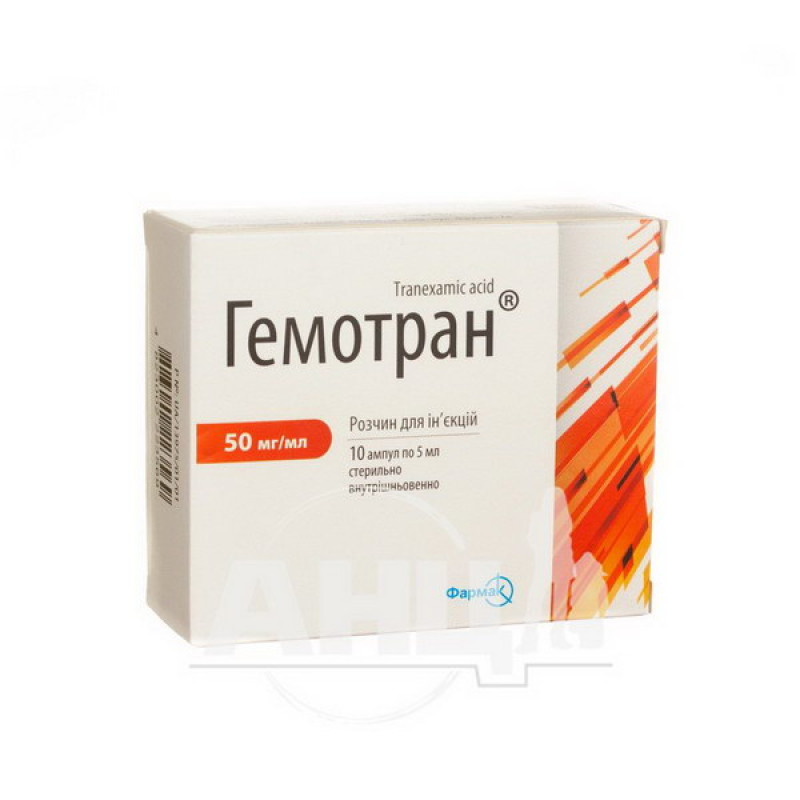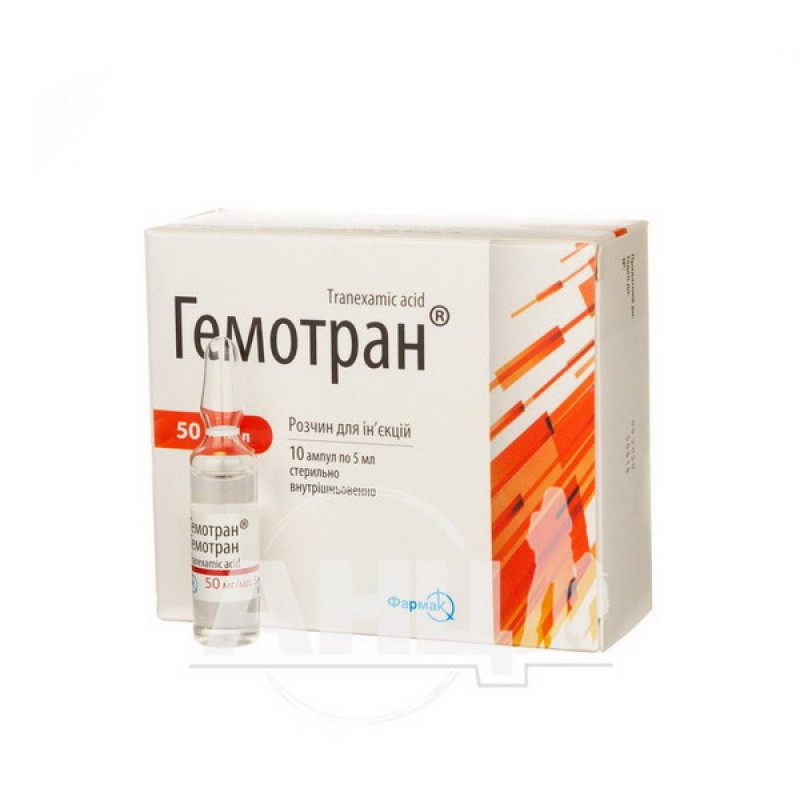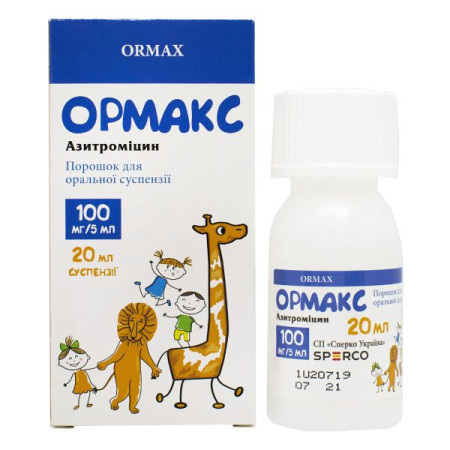Hemotran solution for injection 50 mg/ml ampoule 5 ml No. 10

Pharmacological properties
Pharmacodynamics. Hemotran is an antifibrinolytic agent. Tranexamic acid competitively inhibits the activation of plasminogen and its conversion to plasmin. It has a hemostatic effect in bleeding associated with increased fibrinolysis, as well as anti-allergic and anti-inflammatory effects by preventing the formation of kinins and other active peptides that are involved in allergic and inflammatory reactions.
Pharmacokinetics. After intravenous administration of a dose of 1 g, AUC shows triexponential kinetics with an average T ½ of approximately 2 h in the terminal elimination phase. The initial volume of distribution is approximately 9-12 l. Excreted in the urine. It is excreted by the kidneys by glomerular filtration. The total level of renal excretion is equivalent to the total clearance of blood plasma (110-116 ml/min). More than 95% of the administered dose is excreted in the urine unchanged. Approximately 90% of tranexamic acid is excreted within 24 hours after intravenous administration of the drug at a dose of 10 mg/kg body weight. Tranexamic acid crosses the placental barrier. The concentration in umbilical cord blood after intravenous administration of the drug at a dose of 10 mg/kg in pregnant women is about 30 mg/l. Tranexamic acid rapidly penetrates the synovial fluid and synovial membrane. In synovial fluid, it reaches the same concentration as in blood plasma. T ½ of tranexamic acid from synovial fluid is about 3 hours. The concentration of tranexamic acid in the blood is lower than in other tissues. In breast milk, the concentration is about 1/100 C max in blood plasma. The concentration of tranexamic acid in cerebrospinal fluid is about 1/10 of the concentration in blood plasma, in intraocular fluid - about 1/10 of the concentration in blood plasma.
Indication
Bleeding or risk of bleeding with increased fibrinolysis, both generalized (bleeding during prostate surgery and in the postoperative period, hemorrhagic complications of fibrinolytic therapy) and local (uterine, gastrointestinal bleeding, bleeding after prostatectomy, tonsillectomy, cervical conization, tooth extraction in patients with hemophilia).
Application
Administer intravenously (drip, jet).
The dosage regimen is individual, depending on the clinical situation.
In case of generalized fibrinolysis, administer in a single dose of 15 mg/kg every 6-8 hours, administration rate - 1 ml/min.
For local fibrinolysis, it is recommended to use the drug at a dose of 200-500 mg 2-3 times a day.
For prostatectomy, administer 1 g during surgery, then 1 g every 8 hours for 3 days, then switch to taking the tablet form of tranexamic acid until the gross hematuria disappears.
If there is a significant risk of bleeding, with a systemic inflammatory reaction, it is recommended to use the drug at a dose of 10-11 mg/kg 20-30 minutes before the intervention.
Patients with coagulopathy should be given the drug at a dose of 10 mg/kg before tooth extraction, and after tooth extraction, oral administration of the tablet form of tranexamic acid should be prescribed.
In cases of impaired renal excretory function, correction of the dosage regimen is necessary: at a creatinine concentration in the blood of 120-250 μmol/l - 10 mg/kg 2 times a day; at a concentration of 250-500 μmol/l - 10 mg/kg 1 time a day; at a concentration of 500 μmol/l - 5 mg/kg 1 time a day.
Children: Single dose is 10 mg/kg, administered twice daily.
Elderly patients: In the absence of impaired renal excretory function, dose adjustment is not required.
Contraindication
Hypersensitivity to tranexamic acid and the components of the drug. thromboembolic diseases in the past, high risk of thrombosis, severe renal failure, macroscopic hematuria, myocardial infarction, subarachnoid hemorrhage, coagulopathy due to disseminated intravascular coagulation (DIC) without significant activation of fibrinolysis, color vision impairment.
Side effects
Gastrointestinal tract: nausea, vomiting, diarrhea, feeling of discomfort in the stomach and intestines.
Nervous system: convulsions, dizziness.
From the cardiovascular system: arterial hypotension (especially after rapid intravenous administration), orthostatic hypotension, thromboembolism, deep vein thrombosis, pulmonary embolism, cerebral thrombosis.
From the urinary system: acute necrosis of the renal cortex.
On the part of the organ of vision: visual impairment, chromatopsia.
Hypersensitivity reactions, including anaphylaxis, skin rashes, are possible.
Special instructions
Intravenous administration should be administered slowly. Tranexamic acid should not be administered intramuscularly.
Rapid intravenous administration may cause dizziness and hypotension. To avoid hypotension, the drug should be administered slowly and at a rate of no more than 1 mg/min.
In patients with DIC, treatment should be restricted to those with predominantly activated fibrinolytic systems with acute bleeding. Typically, the hematological profile is similar to the following: shortened euglobulin fibrinolytic activity; prolonged prothrombin time; decreased plasma fibrinogen, factors V and VIII, plasminogen, and α2-macroglobulin; normal plasma P and P-complex levels, i.e. factors II (prothrombin), VIII, and X; elevated plasma fibrinogen degradation products; and elevated platelet count. The above assumes that the underlying disease does not modify the various elements of this profile. In these acute cases, a single dose of 1 g of tranexamic acid is often sufficient to control bleeding. With normal renal function, fibrinolytic activity in the blood will be reduced by approximately 4 hours. Patients with thrombohemorrhagic complications should not use the drug simultaneously with anticoagulants (heparin) to prevent further fibrin deposition. The use of Hemotran should only be considered if hematological laboratory facilities are available and there is experience in their use.
During treatment, observation by an ophthalmologist is necessary for several days to check visual acuity, color vision, determine visual fields, and examine the fundus.
Use tranexamic acid with caution in patients taking oral contraceptives, as the risk of thrombosis is increased.
Convulsions have been reported with the use of tranexamic acid. Most of these cases have been reported after intravenous administration of high doses of tranexamic acid during coronary artery bypass grafting. When using the recommended low doses of tranexamic acid, the incidence of postoperative seizures is similar to that observed in patients not receiving tranexamic acid.
Use during pregnancy or breastfeeding. Use only if clearly needed.
Although there is no evidence of teratogenic or other adverse effects during pregnancy, when prescribing the drug, it is necessary to constantly monitor the patient's health. Since tranexamic acid penetrates into breast milk in an amount equal to approximately 1% of the concentration of the drug in the mother's blood plasma, in this case, an antifibrinolytic effect in the infant is unlikely, but if necessary, breastfeeding is recommended to be discontinued.
Children. The drug is not used in pediatric practice.
The ability to influence the reaction speed when driving or working with other mechanisms.
In cases of adverse reactions from the central nervous system and/or the organ of vision, you should refrain from driving vehicles or working with other mechanisms.
Interactions
The drug can be used with isotonic sodium chloride and glucose solution, 20% fructose solution, 10% invertase solution, dextran 40 or 70, Ringer's solution. The drug should be used with caution in combination with heparin in patients with blood clotting disorders.
Heparins can be added to intravenous drip administration.
Concomitant therapy with chlorpromazine and tranexamic acid in patients with subarachnoid hemorrhage may lead to cerebral vasospasm and cerebral ischemia, and a decrease in cerebral blood flow is also possible.
The drug is incompatible with urokinase, norepinephrine bitartrate, desoxyepinephrine hydrochloride, dipyridamole, diazepam.
Use with caution in patients receiving antifibrinolytic therapy.
When used simultaneously with estrogens, the risk of blood clots increases.
Overdose
Symptoms: nausea, vomiting, orthostatic symptoms, arterial hypotension.
Treatment: symptomatic therapy, forced diuresis, maintenance of water-salt balance.
Storage conditions
In the original packaging at a temperature not exceeding 25 c.
Translation of the instructions can be
There are no reviews for this product.
There are no reviews for this product, be the first to leave your review.
No questions about this product, be the first and ask your question.








